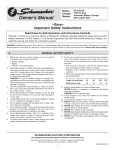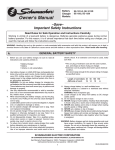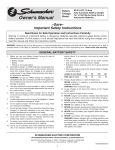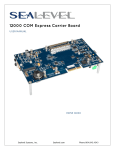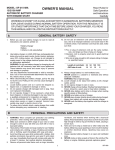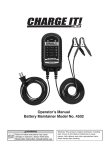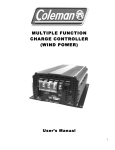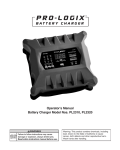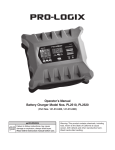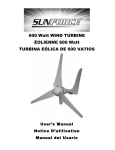Download Schumacher SF-2150MA Owner`s manual
Transcript
Battery Charger Model: Owner's Manual SE-2150MA 2/15/110 Amp Automatic Battery Charger With Engine Start –Save– Important Safety Instructions Read Rules for Safe Operation and Instructions Carefully Working in vicinity of a lead-acid battery is dangerous. Batteries generate explosive gases during normal battery operation. For this reason, it is of utmost importance that each time before using your charger, you read this manual and follow the instructions exactly. WARNING: Handling the cord on this product or cords associated with accessories sold with this product, will expose you to lead, a chemical known to the State of California to cause cancer and birth defects or other reproductive harm. Wash hands after handling. A. 1. GENERAL BATTERY SAFETY Before you use your battery charger, be sure to read all instructions and cautions printed on: 10. Do not use an extension cord unless absolutely necessary. Use of an improper extension cord could result in fire or electric shock. If an extension cord must be used, make sure that: • Battery Charger • Battery • Vehicle or unit using battery 2. 3. 4. 5. 6. 7. 8. 9. • Pins on plug of extension cord are the same number, size, and shape as those of plug on charger. • Extension cord is properly wired and in good electrical condition. • Wire size is large enough for AC ampere rating of charger, as specified below: Use battery charger on LEAD ACID type rechargeable batteries only, such as used in autos, trucks, tractors, airplanes, vans, RV's, trolling motors, etc. Charger is not intended to supply power to low-voltage electrical system other than in an automotive application. WARNING: Do not use battery charger for charging drycell batteries that are commonly used with home appliances. These batteries may burst and cause injury to persons and damage to property. Use only attachments recommended or sold by manufacturer. Use of non-recommended attachments may result in fire, electric shock, or injury. When disconnecting the battery charger, pull by the plug not by the cord. Pulling on the cord may cause damage to cord or plug. Locate battery power cord so it cannot be stepped on, tripped over, or subjected to damage or stress. Do not operate charger with damaged cord or plug. Have cord replaced immediately. Do not operate charger if it has received a sharp blow, been dropped, or otherwise damaged in any way. Take it to a qualified professional for inspection and repair. Do not disassemble charger. Take it to a qualified professional when service or repair is required. Incorrect reassembly may result in electric shock or fire. To reduce risk of electric shock, unplug charger from outlet before attempting any maintenance or cleaning. Length of cord (feet): 25 50 100 150 AWG size of cord: 16 14 10 8 11. Always charge battery in a well ventilated area. NEVER operate in a closed-in or restricted area without adequate ventilation. WARNING: Risk of explosive gas. 12. Locate charger as far away from battery as DC charger cables permit. 13. Do not expose charger to rain or snow. 14. NEVER charge a frozen battery. If battery fluid (electrolyte) is frozen, bring into a warm area to thaw before charging. 15. NEVER allow battery acid to drip on charger when reading specific gravity or filling battery. 16. NEVER set a battery on top of charger. 17. NEVER place charger directly above battery being charged. Gases from battery will corrode and damage charger. 18. NEVER touch the battery clips together when the charger is energized. SCHUMACHER ELECTRIC CORPORATION 801 BUSINESS CENTER DRIVE • MOUNT PROSPECT, ILLINOIS 60056-2179 Send Warranty Product Repairs to: 1025 E. Thompson, Hoopeston, IL 60942-0280 Call Customer Service if you have questions: 1-800-621-5485 00-99-000-267/0103 1 B. 1. 2. 3. 4. 5. WARNING: Wear complete eye protection and clothing protection, when working with lead-acid batteries. Make sure someone is within range of your voice or close enough to come to your aid when you work with or near a lead-acid battery. Have plenty of fresh water and soap nearby for use if battery acid contacts skin, clothing, or eyes. If battery acid contacts skin or clothing, wash immediately with soap and water. Avoid touching your eyes while working with a battery. Acid particles (corrosion) may get into your eyes! If acid enters your eye, immediately flood eye with running cold water for at least 10 minutes. Get medical attention immediately. Remove all personal metal items such as rings, bracelets, C. 1. 2. 3. 4. PERSONAL PRECAUTIONS AND SAFETY 6. 7. 8. necklaces, and watches when working with a lead-acid battery. A lead-acid battery can produce a short-circuit current high enough to weld a ring (or the like) to metal, causing a severe burn. Take care not to drop a metal tool or other metal onto the battery. Metal may cause sparking or short circuit the battery or another electrical devise. Sparking may cause an explosion. Always operate battery charger in an open well ventilated area. NEVER smoke or allow a spark or flame in the vicinity of the battery or engine. Batteries generate explosive gases! PREPARING TO CHARGE Make sure you have a 6 or 12 volt lead-acid battery. Check car owner manual to make sure. Clean battery terminals. Take care to keep corrosion from coming in contact with your eyes. If required, add distilled water in each cell until battery acid reaches levels specified by battery manufacturer. This helps purge excessive gas from cells. Do not overfill. For a battery without cell caps, carefully follow manufacturer's recharging instructions. Study all battery manufacturer's specific precautions, such as removing or not removing cell caps while charging, and recommended rates of charge. 5. 6. 7. 8. GROUNDING AND AC POWER CORD CONNECTION INSTRUCTIONS - Charger should be grounded to reduce risk of electric shock. Charger is equipped with an electric cord having an equipment-grounding conductor and a grounding plug. The plug must be plugged into an outlet that is properly installed and grounded in accordance with local codes and ordinances. Be sure area around battery is well ventilated while battery is being charged. Gas can be forcefully blown away by using a piece of cardboard or other non-metallic material as a fan. If necessary to remove battery from vehicle to charge, always remove grounded terminal from battery first. Make sure all accessories in the vehicle are off, so as not to cause an arc. A marine (boat) battery must be removed and charged on shore. To charge it on board requires equipment specially designed for marine use. Select charge rate suitable for the battery being charged (2 or 15 Amps). GROUNDED OUTLET ADAPTER METAL SCREW DANGER - Never alter AC cord or plug provided - if it will not fit outlet, have proper outlet installed by a qualified electrician. Improper connection can result in a risk of electric shock. COVER OF GROUNDED OUTLET BOX This battery charger is for use on a nominal 120-volt circuit, and has a grounding plug that looks like the plug illustrated in sketch A. A temporary adapter, which looks like the adapter illustrated in sketch B, may be used to connect this plug to a two-pole receptacle as shown in sketch B if a properly grounded outlet is not available. The temporary adapter should be used only until a properly grounded outlet can be installed by a qualified electrician. (A) (B) GROUNDING PIN Grounding Methods DANGER - Before using adapter as illustrated, be certain that center screw of outlet plate is grounded. The green-colored rigid ear or lug extending from adapter must be connected to a properly grounded outlet - make certain it is grounded. If necessary, replace original outlet cover plate screw with a longer screw that will secure adapter ear or lug to outlet cover plate and make ground connection to grounded outlet. During operation do not place the charger or its cables on the vehicle seat or carpeting. When charging a battery in a boat, RV or motor home always connect one lead of the output cable to the battery. Never connect to a remote receptacle or other means for the purpose of remotely charging the battery. The wires may be inadequate for handling the charge current of this charger and may over heat. Often these wires are bundled in with other wires which could be damaged and lead to a direct short across the battery and charger. If this occurs a fire can result, equipment and appliances operated from the battery may also be damaged. 2 D. METER AND SWITCH FUNCTIONS BATTERY TYPE: You may select between two basic Battery Types: Regular or Deep Cycle Battery. Both settings operate automatically and will shut off when the battery is fully charged. Use the Regular for all wet-cell, lead-acid batteries. (This charger is not recommended for Gel-Cell and AGM batteries.) Use the Deep Cycle setting for all Deep Cycle wet-cell, lead-acid batteries. How can you tell your battery type? Deep Cycle batteries are usually marked as such. If not, the battery will fall under the category of "Regular" batteries. Most automotive batteries are considered "Regular" batteries. DC AMPS CHARGING 0 FULL CHARGE Some Deep Cycle batteries are designed in a way that charging them in the Regular setting is more suitable. When charging a Deep Cycle battery, if the Full Charge indicator lamp does not become illuminated after a 12-hour charge period and the charge current as indicated by the Amp Meter is less than 8 amps, move the switch to the Regular setting. If the Full Charge indicator lamp still remains off after charging, you should disconnect the charger and have both the battery and charger professionally tested. L DEEP CYCLE BATTERIES AUTOMATIC OPERATION 12 VOLT, 15 AMP: Used for charging medium and large size wet-cell, lead-acid, 12-volt batteries. (Automatic Operation.) 12 VOLT, 110 AMP ENGINE START: Used for crank starting of 12 volt vehicles. The Engine Start position should not be used for battery charging, doing so will cause the charger to overheat and then protect itself by cycling off and on. (Manual Operation.) CHARGE RATE SELECTOR L L 2 Amp 15 Amp 12V Automatic CHECK BATTERY When using the 2 amp charge rate the meter may indicate some activity but doesn’t have the resolution to accurately display the battery’s state of charge. For this reason you should depend on the full charge light indicator. 12 VOLT, 2 AMP: The 2 amp automatic charge rate is recommended for charging small batteries and warming large ones. If used for maintaining the Full Charge level of larger batteries, limit the charge period to a few days at a time. (Automatic Operation.) L 15 The START area of the meter is reserved to indicate when a high rate of current is being drawn from the charger. It is normal for the meter pointer to be in this area while cranking a vehicle. 6 VOLT, 15 AMP: Used for charging medium and large size wet-cell, lead-acid 6 volt batteries. Do not charge small batteries such as used in motorcycles, lawn and garden equipment. (Manual Operation. Monitor frequently while charging a battery.) 15 Amp 6V, Manual START 10 METER: The meter indicates the amount of current measured in amperes that is being drawn from the charger by a battery. In the 15 amp charge rate a typical discharged battery may initially draw more than 15 amps during the first few minutes of charge. As the battery continues to charge current should gradually taper to within 6 to 8 amps at full charge. OPERATION SELECTOR REGULAR BATTERIES L AUTOMATIC OPERATION 5 L 110 Amp 12V Engine Start 3 E. OPERATING INSTRUCTIONS: CHARGING BATTERY IN VEHICLE When charging battery in the vehicle, take care to determine the battery type and which post is grounded. To reduce risk of a spark near battery, follow these steps when battery is installed in vehicle. WARNING: A spark near battery may cause battery explosion. 1. 2. 3. 4. WARNING: Do not connect clip to carburetor, fuel lines, or sheetmetal body parts. NOTE: Attach clips to battery post and twist or rock back and forth several times to make a good connection. This tends to keep clips from slipping off terminals and helps to reduce risk of sparking. Position AC power cord and DC charging cords to reduce risk of damage by hood, door, or moving engine parts. Stay clear of fan blades, belts, pulleys, and other parts that can cause injury. Check polarity of battery posts. Battery case will be marked by each post: POSITIVE (POS, P, +) and NEGATIVE (NEG, N, -). NOTE: The positive battery post usually has a larger diameter than the negative post. Determine which post of battery is ground (connected) to chassis. NOTE: The negative post is normally grounded. 6. 7. 8. 9. NEGATIVE GROUNDED POST 5A. For negative-grounded vehicle, connect POSITIVE (RED) clip from battery charger to POSITIVE (POS, P, +) ungrounded post of battery. Connect NEGATIVE (BLACK) clip to vehicle chassis or engine block away from battery. Connect to a heavy gauge metal part of the frame or engine block. Make all desired settings before applying AC power to the charger. Observe the meter for proper response, if something does not look right, refer to the trouble shooting section of this manual. When battery is fully charged, unplug charger from AC outlet. Remove charger clips from (1) chassis and (2) battery post, in that order. POSITIVE GROUNDED POST 5B. For positive-grounded vehicle, connect NEGATIVE (BLACK) clip from battery charger to NEGATIVE (NEG, N, -) ungrounded post of battery. Connect POSITIVE (RED) clip to vehicle chassis or engine block away from battery. Connect to a heavy gauge metal part of the frame or engine block. F. OPERATING INSTRUCTIONS: CHARGING BATTERY OUT OF VEHICLE When charging battery out of vehicle, take care to determine the battery type. To reduce risk of a spark near battery, follow these steps when battery is outside vehicle. WARNING: A spark near the battery may cause battery explosion. WARNING: When removing battery from vehicle or boat, disconnect grounded pole first. When disconnecting, make sure all accessories are off, so as not to cause an arc. (NOTE: A marine (boat) battery must be removed and charged on shore. (To charge on board requires special equipment designed for marine use.) WARNING: When reinstalling battery, attach the ground post first. 1. 2. 3. 4. 5. 6. 7. Check polarity of battery posts. Battery case will be marked by each post: POSITIVE (POS, P, +) and NEGATIVE (NEG, N, -). NOTE: The positive battery post usually has a larger diameter than the negative post. Attach a 24-inch long (or longer) 6-gauge (AWG) insulated battery cable to NEGATIVE (NEG, N, -) battery post. Connect POSITIVE (RED) charger clip to POSITIVE (POS, P, +) post battery. Rock clip back and forth to make good connection. Position yourself and free end of 24 inch cable as far away from battery as possible. Then connect NEGATIVE (BLACK) charger clip to free end of cable. WARNING: Do not face battery when making final connection. Rock clip back and forth to make a good connection. Make all desired settings before applying AC power to the charger. Observe the meter for proper response, if something does not look right, refer to the troubleshooting section of this manual. When battery is fully charged, unplug charger from AC power source. POSITIVE NEGATIVE BATTERY CHARGER BATTERY + 24", 6 GUAGE CABLE CONNECT NEGATIVE BATTERY CLIP TO 24 INCH CABLE END 8. 9. POWER CORD TO GROUNDED POWER OUTLET When battery is fully charged and charger is unplugged, (1) remove clip from end of Negative end of cable, and (2) remove clip from Positive battery post, in that order. Clean and store battery charger. WARNING: Be sure area around battery is well ventilated while battery is being charged. Gas can be forcefully blown away by using a piece of cardboard or other non-metallic material as a fan. 4 G. 1. 2. 3. 4. 5. 6. 7. OPERATING INSTRUCTIONS: ENGINE START TROUBLESHOOTING If a problem does occur, check the following: Connect the battery charger to the vehicle according to section E (CHARGING BATTERY IN VEHICLE) found earlier in this manual. Performance will be enhanced if you charge the battery for 5-10 minutes in the 12v 15 amp position before attempting to start. Set the charge rate selector switch to the 110 amp start position. Crank the engine for 2-4 seconds. If the engine fails to start, charge the battery in the 12v 15 amp position for another 5-15 minutes and then attempt to start the engine again. If the engine fails to start after several attempts, there may be a problem elsewhere with the vehicle. When disconnecting, always disconnect power cord first, then remove clip from vehicle chassis, and finally remove the clip from the battery terminal. H. PROBLEM POSSIBLE CAUSE SOLUTION No meter reading. Clips are not making a good connection Rock clips back and forth for a better connection. AC Cord unplugged. Plug AC line into outlet. Meter should now indicate. AC outlet is dead. Plug in a lamp to check for voltage. Poor electrical connection. Check connectors, rock back and forth for a better connection. Circuit breaker is cycling. May be in the wrong switch position. Battery is defective. Have Battery checked. Severely discharged battery but otherwise a good battery. Allow charging to continue until battery has a chance to recover sufficiently to take a charge. If more than 20 minutes stop charging and have the battery checked. Reverse connections at battery. Shut off charger and correct lead connections. Charger will not turn on when properlyconnected. Clicking noise from charger. CHARGE PERIOD The approximate time required to bring a battery to a full charge state depends upon the number of ampere hours (AH’s) depleted from the battery. AH’s are determined by multiplying the number of hours times the number of amps supplied by a battery to a load. For example - if a load was connected to a battery which drew 10 Amps for a period of 5 hours, the battery will have supplied 50 AH’s. The approximate recharge time required to restore the 50 AH’s depleted from the battery would be calculated by dividing 50 AH’s by the selected charge rate. If the 15 Amp charge rate is chosen then divide 50 AH’s by 15 Amps, this equal to 3.3 hours or 3 hour and 20 minutes. During the charge cycle, the 15 Amp charge rate will not remain constant, rather as the battery charges it will taper to approximately 6-7 Amps. Also not all of the energy going into the battery is directly converted, some is lost in the form of heat. For these reasons allow an additional 25% in charge time. For this example add 50 minutes to the 3 hour and 20 minutes for a total recharge time of 4 hour and 10 minutes. LIMITED WARRANTY SCHUMACHER ELECTRIC CORPORATION, 801 BUSINESS CENTER DRIVE, MOUNT PROSPECT, ILLINOIS 60056-2179 MAKES THIS LIMITED WARRANTY TO THE ORIGINAL PURCHASER AT RETAIL OF THIS PRODUCT. THIS LIMITED WARRANTY IS NOT TRANSFERABLE. Schumacher Electric Corporation warrants this battery charger for two years from date of purchase at retail against defective material or workmanship. If such should occur, the unit will be repaired or replaced at the option of the manufacturer. It is the obligation of the purchaser to forward the unit together with proof of purchase, transportation and/or mailing charges prepaid to the manufacturer or its authorized representative. This limited warranty is void if the product is misused, subjected to careless handling, or repaired by anyone other than the manufacturer or its authorized representative. The manufacturer makes no warranty other than this limited warranty and expressly excludes any implied warranty including any warranty for consequential damages. 50 = 3 Hours 20 Minutes 15 THIS IS THE ONLY EXPRESS LIMITED WARRANTY AND THE MANUFACTURER NEITHER ASSUMES NOR AUTHORIZES ANYONE TO ASSUME OR MAKE ANY OTHER OBLIGATION TOWARDS THE PRODUCT OTHER THAN THIS EXPRESS LIMITED WARRANTY. THE MANUFACTURER MAKES NO WARRANTY OF MERCHANTABILITY OR FITNESS FOR PURPOSE OF THIS PRODUCT AND EXPRESSLY EXCLUDES SUCH FROM THIS LIMITED WARRANTY. 3 Hours (180 minutes + 20 minutes = 200 minutes) 200 x 1.25 = 250 minutes or 4 Hours & 10 minutes SOME STATES DO NOT ALLOW THE EXCLUSION OR LIMITATION OF INCIDENTAL OR CONSEQUENTIAL DAMAGES OR LENGTH OF IMPLIED WARRANTY SO THE ABOVE LIMITATIONS OR EXCLUSIONS MAY NOT APPLY TO YOU. THIS WARRANTY GIVES YOU SPECIFIC LEGAL RIGHTS AND YOU MAY ALSO HAVE OTHER RIGHTS WHICH VARY FROM STATE TO STATE. 5 MANUAL DEL PROPIETARIO B. PRECAUCIONES Y SEGURIDAD PERSONALES EL TRABAJAR CERCA DE BATERIAS DE PLOMO-ACIDO ES PELIGROSO. LAS BATERIAS GENERAN GASES EXPLOSIVOS DURANTE LA OPERACION NORMAL DE LA BATERIA. POR ESTA RAZON ES SUMAMENTE IMPORTANTE QUE LEA ESTE MANUAL Y OBSERVE EXACTAMENTE LAS INSTRUCCIONES CADA VEZ QUE SE USE EL CARGADOR. 1. 2. 3. A. SEGURIDAD GENERAL DE LA BATERIA 4. 1. Antes de usar su cargador de batería, asegúrese de leer todas las instrucciones y los avisos de precauciones impresos en: • El cargador de batería • La batería • El vehículo o la unidad que usa la batería 2. Use el cargador de batería sólo en baterías recargables de tipo PLOMOACIDO, tales como aquellas usadas en trocas, carros, tractores, aviones, motores de troles, camionetas, RV, etc. El cargador no está diseñado para suministrar energía a un sistema eléctrico de bajo voltaje diferente a una aplicación automotriz. ADVERTENCIA: No use el cargador de batería para cargar baterías de célula seca que se usan comúnmente con artefactos domésticos. Estas baterías pueden reventar y causar lesiones a las personas y daños a la propiedad. 3. Use sólo los aditamentos recomendados o vendidos por el fabricante. El uso de aditamentos no recomendados puede resultar en un incendio, choque eléctrico o lesiones. 4. Al desconectar el cargador de batería, tire del enchufe y no del cordón. El tirar del cordón puede causar daño al cordón o al enchufe. 5. Coloque el cordón de potencia de la batería de manera que no pueda pisarse, tropezarse con el mismo, o que esté expuesto a daño o esfuerzo. 6. No opere el cargador con un cordón o enchufe dañado. Haga que el cordón sea reemplazado inmediatamente. 7. No opere el cargador si ha recibido un golpe fuerte, se ha caído o se ha dañado de alguna manera. Llévelo a un profesional calificado para inspeccionar y reparar. 8. No desarme el cargador. Llévelo a un profesional calificado cuando se requiera servicio o reparación. Un rearmado incorrecto puede resultar en un choque eléctrico o en un incendio. 9. Desenchufe el cargador del tomacorriente antes de tratar de mantener o limpiar, para reducir el riesgo de choque eléctrico. 10. No use un cordón de extensión a menos que sea absolutamente necesario. El uso de un cable de extensión incorrecto podría resultar en incendio o choque eléctrico. Si debe usarse un cable de extensión, asegúrese que: • Las clavijas del enchufe del cable de extensión sean iguales en cantidad, tamaño y forma a aquéllas del enchufe en el cargador. • El cable de extensión esté apropiadamente cableado y en buen estado eléctrico. • El tamaño del conductor sea suficientemente grande como para la clasificación de amperios de CA del cargador, según se especifica abajo: Longitud del cable (pies): 25 50 100 150 Tamaño AWG del cable: 16 12 10 8 5. 6. 7. 8. 9. ADVERTENCIA: Al trabajar con baterías de plomo-ácido, use protección completa de los ojos y protección de la ropa. Cuando usted trabaje con o esté cerca de una batería de plomo-ácido, asegúrese que alguien esté al alcance de su voz o suficientemente cerca como para ayudarlo. Tenga a mano agua y jabón para usar si el ácido de la batería entra en contacto con la piel, la ropa o los ojos. Lave inmediatamente con jabón y agua si el ácido de la batería entra en contacto la piel o la ropa. Al trabajar con una batería, evite tocar sus ojos. ¡Las partículas ácidas (corrosión) pueden entrar en sus ojos! Lave inmediatamente el ojo con agua corriente fría durante un mínimo de 10 minutos si el ácido penetra en el mismo. Busque atención médica inmediata. Al trabajar con una batería de plomo-ácido, quítese todos los artículos personales de metal tales como anillos, brazaletes, collares y relojes. Una batería de plomo-ácido puede producir una corriente de cortocircuito suficientemente intensa como para soldar un anillo (u objetos similares) al metal, causando una quemadura grave. Tenga cuidado en no dejar caer una herramienta de metal u otro metal sobre la batería. El metal puede causar chispas o colocar en cortocircuito la batería u otro artefacto eléctrico. Las chispas pueden causar una explosión. Opere siempre el cargador de batería en un área abierta y bien ventilada. NUNCA fume ni permita chispas o llamas en la vecindad de la batería o del motor. Las baterías generan gases explosivos! ADVERTENCIA - El manejo del cordón en este producto, o de los cordones asociados con los accesorios vendidos con este producto, le expone a usted al plomo, un producto químico conocido en el Estado de California de causar cáncer y defectos de nacimiento u otros daños reproductivos. Lávese las manos después de manejar estos cordones. C. PREPARANDO LA CARGA 1. 2. 3. 4. 5. 6. 7. 8. (Calibre Americano de Conductor) 11. Cambie siempre la batería en un área bien ventilada. A causa del riesgo de gases explosivos, NUNCA opere en un área cerrada o restringida sin ventilación adecuada. 12. Coloque el cargador tan alejado como sea posible de la batería, a la máxima distancia permitida por los cables del cargador de CC. 13. No exponga el cargador a la lluvia ni a la nieve. 14. NUNCA cargue una batería congelada. Llévela a un área cálida para descongelarla antes de cargar, si el fluido (electrolito) de la batería está congelado. 15. NUNCA permita que el ácido de la batería gotee sobre un cargador al leer la gravedad específica o al llenar la batería. 16. NUNCA coloque el cargador directamente sobre la batería a cargar. Los gases de la batería desgastarán y dañarán el cargador. 17. Al activar el cargador, NUNCA toque al mismo tiempo las pinzas de conexión. 18. NUNCA junte las pinzas de los cables (una con otra) cuando esté engergizado el cardador. Asegúrese que tenga una batería de 12 voltios o de 6 voltios de plomoácido y seleccione correspondientemente el interruptor del cargador de la batería. Limpie los terminales de la batería. Tenga cuidado para evitar que la corrosión entre en contacto con sus ojos. Si fuera requerido, agregue agua destilada a cada célula hasta que el ácido de la batería alcance los niveles especificados por el fabricante de la batería. Esto ayuda a purgar el gas excesivo de las células. No llene en exceso. Siga cuidadosamente las instrucciones de recarga del fabricante para una batería sin tapas individuales de las células. Estudie todas las precauciones específicas del fabricante de la batería, tales como sacar o no sacar las tapas de las células al cargar y velocidades recomendadas de carga. Asegúrese que el área alrededor de la batería esté bien ventilada mientras se carga la batería. El gas puede soplarse alejado usando una pieza de cartón u otro material no metálico como un abanico. Saque siempre el terminal conectado a tierra primero, si fuera necesario sacar la batería del vehículo para cargar. Asegúrese que todos los accesorios en el vehículo estén desconectados de manera que no puedan originar un arco eléctrico. Una batería marina (de barco) puede sacarse y cargarse en tierra. La carga a bordo requiere equipo especialmente diseñado para uso marino. Seleccione el régimen de carga adecuado para la batería que va a ser cargada (2 ó 15 Amperios) INSTRUCCIONES DE PUESTA A TIERRA Y CONEXION DEL CORDON ELECTRICO DE CORRIENTE ALTERNA: El cargador tiene que tener conexión a tierra para reducir el riesgo de choques eléctricos. El cargador está equipado con un cordón que tiene conductor del equipo a tierra por medio de una toma de corriente con conexión a tierra. La clavija se tiene que enchufar en una salida apropiadamente instalada de acuerdo a los códigos y las disposiciones locales. PELIGRO: NUNCA modifique el cordón eléctrico de corriente alterna suministrado – si no entra en la toma de corriente, mande instalar una salida apropiada por un electricista capacitado. Una conexión incorrecta puede tener riesgos de choques eléctricos. Este cargador de acumuladores es paro uso en circuitos de 120 voltios nominales y tiene una clavija con conexión a tierra parecida a la de la ilustración A. Un adaptador provisional, como el de la ilustración B, se puede usar para conectar esta clavija en un receptáculo de dos orificios, como se indica en la ilustración B, si no hay una salida con conexión a tierra. El adaptador provisional se debe usar únicamente hasta que un electricista capacitado 6 El sector "START" del medidor se reserva para indicar cuando se está sacando del cargador un alto nivel de corriente. Es normal que el indicador del medidor esté en esta área durante el arranque un vehículo. batería. Nunca lo conecte a un receptáculo remoto ni a otro dispositivo para cargar la batería desde un lugar distante. Los cables podrían ser inadecuados para resistir la corriente de este cargador y podrían recalentarse. A menudo estos cables vienen unidos con otros cables que podrían resultar dañados y causar un cortocircuito a la batería y al cargador. Si esto sucede se puede provocar un incendio, y por lo tanto se podrían dañar tanto elequipo como los artefactos que se operan con la batería. Al usar el nivel de carga a 2 amperios, el medidor quizás indique alguna actividad mas no tiene la definición necesaria para mostrar con precisión el estado de carga de la batería. Por este motivo se debe depender del indicador luminoso de plena carga. PELIGRO: Antes de usar un adaptador como el que se ilustra, asegúrese que el tornillo de la placa esté haciendo tierra. La lengüeta del adaptador tiene que quedar conectada a una toma de corriente conectada a tierra – verifique que tenga conexión a tierra. Si es necesario, cambie el tornillo de la placa por uno más largo que fije la lengüeta a la placa y haga buena conexión a tierra. E. INSTRUCCIONES DE FUNCIONAMIENTO: CARGA DE UN ACUMULADOR EN UN VEHICULO Al cargar un acumulador en un vehículo, determine cuidadosamente el tipo del acumulador y cuál es el terminal de tierra. Para reducir el riesgo de chispas cerca del acumulador, siga estos pasos cuando el acumulador está instalado en el vehículo. ADVERTENCIA: Una chispa cerca del acumulador puede causar la explosión del acumulador. 1. Coloque el cordón de corriente alterna y los cables de carga de corriente continua de manera que se reduzcan los riesgos de dañar el cofre, las puertas o piezas movibles del motor. 2. Manténgase alejado del ventilador, las bandas, las poleas y otras partes que puedan causar lesiones. 3. Verifique la polaridad de los terminales del acumulador. La caja estará marcada junto a cada terminal: POSITIVO (POS, P, +) y NEGATIVO (NEG, N, -). NOTA: El terminal positivo del acumulador normalmente es de mayor diámetro que el negativo. 4. Determine cuál terminal es el de tierra (conectado al chasis). NOTA: El terminal negativo normalmente está puesto a tierra. D. FUNCIONES DEL MEDIDOR Y DE LOS INTERRUPTORES TIPO DE BATERIA: Ud. puede escoger entre dos tipos Básicos de Batería: El Regular o el del "Deep Cycle" (Ciclo Profundo). En ambos casos, el cargador funciona de modo automático y se apaga una vez que la batería esté a plena carga. Use la posición Regular para toda batería galvánica de pila húmeda. (No se recomienda este cargador para las baterías tipo "Gel-Cell" o AGM). Use la posición de "Deep Cycle" para toda batería de ese tipo de pila húmeda. ¿Cómo se puede saber cual tipo de batería Ud. tiene? Las baterías "Deep Cycle" por lo general llevan esa identificación. Si no, la batería queda dentro de la categoría de baterías "Regulares". La mayoría de las baterías para automóvil se consideran del tipo "Regular". Algunas baterías "Deep Cycle" han sido diseñados de tal modo que conviene más cargarlas en la posición "Regular". Al cargar una batería "Deep Cycle" si no se queda iluminada la lámpara del indicador de Plena Carga después de un período de cargar de 12 horas y la corriente de carga indicada por el amperímetro está a menos de 8 amperios, mueve el control a la posición "Regular". Si la lámpara del indicador de Plena Carga aún sigue apagada después de cargar la batería, se debe desconectar el cargador y hacer que un profesional pruebe tanto la batería como el cargador. TERMINAL NEGATIVO A TIERRA 5A. Para vehículos con tierra negativa, conecte la pinza POSITIVA (ROJA) desde el cargador de acumuladores al terminal POSITIVO (POS, P, +) que no está conectado a tierra. Conecte la pinza NEGATIVA (NEGRA) al chasis del vehículo o al monobloc, alejado del acumulador. Conéctelo a una parte de metal grueso del chasis o al monobloc. TERMINAL POSITIVO A TIERRA 6 VOLTIOS, 15 AMPERIOS: Se usa para cargar las baterías galvánicas de pila húmeda a 6 voltios, de tamaños mediano y grande. No se debe cargar las baterías pequeñas tales como las usadas en motocicletas, y equipos para césped y jardines. (Operación Manual. Hay que vigilar el proceso a menudo mientras se carga la batería.) 5B. Para vehículos con tierra positiva, conecte la pinza NEGATIVA (NEGRA) del cargador de acumuladores al terminal NEGATIVO (NEG, N, -) que no está conectado a tierra. Conecte la pinza POSITIVA (ROJA) al chasis del vehículo o al monobloc, alejado del acumulador. Conéctelo a una parte de metal grueso del chasis o al monobloc. ADVERTENCIA: No conecte la pinza al carburador, a una línea de combustible o a una lámina de la carrocería. NOTA: Ponga la pinza en el terminal del acumulador girándolo de ida y vuelta varias veces para hacer un buen contacto. Esto ayuda a mantener la pinza para que no se resbale del terminal y reduce el riesgo de chispas. 6. Haga todos los ajustes deseados antes de aplicarle corriente alterna al cargador. 7. Observe el medidor para ver las respuestas. Si algo no parece estar bien, vea la sección de detección de desperfectos de este manual. 8. Cuando el acumulador está completamente cargado, desenchufe el cargador de la toma de corriente alterna. 9. Quite las pinzas en el siguiente orden: (1) del chasis y (2) del terminal del acumulador. SELECTOR DE OPERACION BATERIAS REGULARES L OPERACION AUTOMATICA L BATERIAS "DEEP CYCLE" OPERACION AUTOMATICA 12 VOLTIOS, 2 AMPERIOS: La carga automática a 2 amperios se recomienda para cargar las baterías pequeñas o para calentar las grandes. Si se usa para mantener el nivel de Plena Carga de las baterías más grandes, se debe limitar el período de carga a no más de unos pocos días cada vez. (Operación automática.) 12 VOLTIOS, 15 AMPERIOS: Se usa para cargar las baterías galvánicas de pila húmeda a 12 voltios, de tamaños mediano y grande. (Operación Automática) F. INSTRUCCIONES DE FUNCIONAMIENTO: CARGA DEL ACUMULADOR DESMONTADO DEL VEHICULO Al cargar el acumulador desmontado del vehículo, tenga cuidado de determinar el tipo del acumulador. Para reducir el riesgo de una chispa cerca del acumulador, siga estos pasos cuando esté fuera del vehículo. ADVERTENCIA: Una chispa cerca del acumulador puede causar una explosión del acumulador. ADVERTENCIA: Al quitar un acumulador de un vehículo o de una embarcación, desconecte el terminal de tierra primero. Antes de desconectarlo, cerciórese que estén apagados todos los accesorios para evitar arcos. NOTA: Un acumulador marino (de embarcación) se tiene que desmontar para cargarlo en tierra (para poder cargarlo a bordo, se tiene que hacer con equipo especial diseñado para uso marino). ADVERTENCIA: Al reinstalar un acumulador, conecte el conductor de tierra primero. 12 VOLTIOS, 110 AMPERIOS "ENGINE START" (ARRANQUE DEL MOTOR): Se usa para arranque de vehículos a 12 voltios con ayuda del cargador . La posición de "Engine Start" no se debe usar para cargar baterías; el hacer esto hará que el cargador se sobrecaliente y luego para protegerse, se irá enciendo y apagando. (Operación Manual). MEDIDOR: El medidor indica en amperios la cantidad de corriente que la batería está sacando del cargador. Al nivel de carga de 15 Amperios, una batería típicamente descargada puede al principio sacar más de 15 Amperios durante los primeros pocos minutos de la carga. A medida que la batería sigue cargándose, la corriente debe gradualmente disminuirse hasta quedar dentro de 6 a 8 amperios a plena carga. 1. SELECTOR DE NIVEL DE CARGA 2. L L L L 3. 15 Amperios 2 Amperios 15 Amperios 110 Amperios 12V 6V Manual "ENGINE START" 12V Automático 7 Verifique la polaridad de los terminales del acumulador. La caja estará marcada junto a cada terminal: POSITIVO (POS, P, +) y NEGATIVO (NEG, N, -). NOTA: El terminal positivo del acumulador normalmente es de mayor diámetro que el negativo. Conecte un cable aislado de acumulador de 61cm (24”) o más, calibre 6 (AWG) al terminal NEGATIVO (NEG, N, -). Conecte la pinza POSITIVA (ROJA) del cargador al terminal POSITIVO (POS, P, +) del acumulador. Gire la pinza de ida y vuelta para hacer un buen contacto. 4. 5. 6. 8. 9. IDENTIFICACIÓN Y SOL UCIÓN DE PROBLEMAS SOLUCIÓN Si ocurre un problema, revise lo siguiente: Colóquese a sí mismo y al extremo del cable aislado de 61cm tan lejos como pueda del acumulador. Luego, conecte la pinza NEGATIVA (NEGRA) del cargador al extremo libre del cable. ADVERTENCIA: No se quede de frente hacia el acumulador al hacer la conexión final. Gire la pinza de ida y vuelta para hacer un buen contacto. Haga todos los ajustes antes de aplicar la corriente alterna al cargador. Observe los medidores para ver las respuestas. Si algo no parece estar bien, vea la sección de detección de desperfectos de este manual. Cuando está completamente cargado el acumulador, desenchufe el cargador de la toma de corriente alterna. (1) Quite la pinza del extremo del cable negativo y luego, (2) Quite la pinza del terminal positivo, en ése orden. Limpie y guarde el cargador de acumuladores. ADVERTENCIA: Verifique que el área alrededor del acumulador esté bien ventilada durante la carga. Puede sacar el gas del área soplándolo con una hoja de cartón u otro material no metálico usado como abanico. PROBLEMA No hay lectura en el medidor POSIBLE CAUSA SOLUCIÓN Los terminales del cable no están bien conectados. Mueva los terminales hacia atrás y adelante para hacer una mejor conexión. (Cordón de corrientte desconectado). Conecte la línea de corriente al tomacorriente. Ahora debería haber una lectura en el medidor. El cargador no enciende incluso cuando esta conectado bien. No hay electricidad en el tomacorriente. Enchufe una lámpara para revisar si hay corriente. Mala conexión eléctrica. Revise conectores,mueva hacia atrás y adelante para tener mejor conexión. Se escucha un sonido seco en el cargador («click»). El interruptor de circuito está en proceso de ree nganche. Posible posición incorrecta del interruptor. La batería está defectuosa. Haga revisar la batería. Es una batería buena pero está muy descargada. Permita que la batería continúe car-gando hasta haber recuperado la carga. Si pasa más de 20 minutos, pare de cargar la batería y llévela a revisar. Conexión reversa a la batería. Apague el cargador y conecte bien los extremos del cable. G. INSTRUCCIONES DE OPERACION: ARRANQUE DEL MOTOR 1. Conecte el cargador de batería al vehículo según la Sección E (CARGANDO LA BATERÍA EN EL VEHÍCULO) que se encuentra más antes en el presente manual. 2. El rendimiento se mejora si se carga la batería por 5 a 10 minutos en la posición de 12 voltios 15 amperios antes de intentar el arranque. 3. Ponga el interruptor selector de la tasa de carga en la posición de arranque de 110 amperios. 4. Intente arrancar el motor por 2 a 4 segundos. 5. Si el motor no arranca, cargue la batería en la posición de 12 voltios 15 amperios por otros 5 a 15 minutos y luego intente nuevamente el arranque el motor. 6. Si el motor no arranca después de varias tentativas, es posible que haya problema en otra parte del vehículo. 7. Al desconectar, siempre desconecte primero el cordón de energía, luego quite la abrazadera del chasis del vehículo, y finalmente quite la abrazadera del terminal de la batería. H. PERÍODO DE CARGA GARANTIA El tiempo necesario aproximado para cargar completamente (o casi completamente) una batería dependerá del número de amperio-horas (AH) consumidas de la batería. Los AH (amperio-horas) se determinan multiplicando el número de horas por el número amperios suministrados por la batería a la carga. Por ejemplo: si una carga fue conectada a una batería que suministró 10 amperios por un período de cinco horas, la batería habrá suministrado 50 AH (amperio-horas). El tiempo aproximado para recargarla sería calculado dividiendo los 50 AH consumidos por la batería por el régimen de carga de amperios del cargador. Si se elige el régimen de carga de 15 amperios, entonces divida los 50 AH por 15 amperios, lo que es igual a 3.3 horas, o sea 3 hora y 20 minutos. Durante el ciclo de carga, el régimen de carga de 15 amperios no se mantendrá constante, sino más bien a medida que la batería se cargue irá reduciendo hasta aproximadamente 7-8 amperios. Tampoco toda la energía que entra a la batería se convierte directamente; se pierde cierta energía en forma de calor. Por estas razones calcule aproximadamente un 25% más del tiempo de carga. En nuestro ejemplo, aumente 50 minutos al tiempo de 3 hora y 20 minutos, lo que dará como resultado un tiempo de recarga total de 4 hora y 10 minutos. SCHUMACHER ELECTRIC CORPORATION, 801 BUSINESS CENTER DRIVE, MOUNT PROSPECT, ILLINOIS 60056-2179 OTORGA ESTA GARANTIA LIMITADA AL COMPRADOR MINORISTA ORIGINAL DE ESTE PRODUCTO. ESTA GARANTIA LIMITADA NO ES TRANSFERIBLE. Schumacher Electric Corporation garantiza este cargador de batería por dos a partir de la compra minorista por material o mano de obra defectuosos. La unidad será reparada o reemplazada a la opción del fabricante de ocurrir lo anterior. Es obligación del comprador enviar la unidad con prueba de compra, con los cargos de transporte y/o franqueo postal pagos al fabricante o a su representante autorizado. La garantía limitada es nula si el producto se ha usado mal, ha sido sujeto a un manejo descuidado o ha sido reparado por alguna persona distinta al fabricante o su representante autorizado. El fabricante no efectúa ninguna representación distinta a esta garantía limitada y expresamente excluye cualquier garantía implícita incluyendo cualquier garantía por daños consecuentes. ESTA ES LA UNICA GARANTIA EXPRESA LIMITADA Y EL FABRICANTE NO ASUME NI AUTORIZA A NADIE A ASUMIR CUALQUIER OTRA OBLIGACION CON RESPECTO AL PRODUCTO DISTINTA A ESTA GARANTIA EXPRESA LIMITADA. EL FABRICANTE NO OTORGA NINGUNA GARANTIA DE COMERCIALIZACION O ADAPTABILIDAD DE ESTE PRODUCTO Y EXCLUYE EXPRESAMENTE AQUELLAS DE ESTA GARANTIA LIMITADA. ALGUNOS ESTADOS NO PERMITEN LA EXCLUSION O LIMITACION DE DAÑOS INCIDENTALES O CONSECUENTES O LA DURACION DE LA GARANTIA IMPLICITA DE MANERA QUE LAS LIMITACIONES O EXCLUSIONES EXPUESTAS ARRIBA PUEDEN NO APLICARSE A USTED. ESTA GARANTIA LE OTORGA DERECHOS LEGALES ESPECIFICOS Y USTED PUEDE TENER TAMBIEN OTROS DERECHOS QUE VARIAN DE ESTADO A ESTADO. 8








